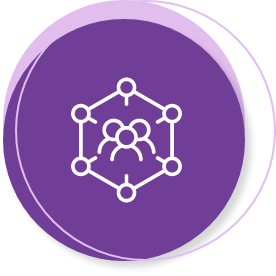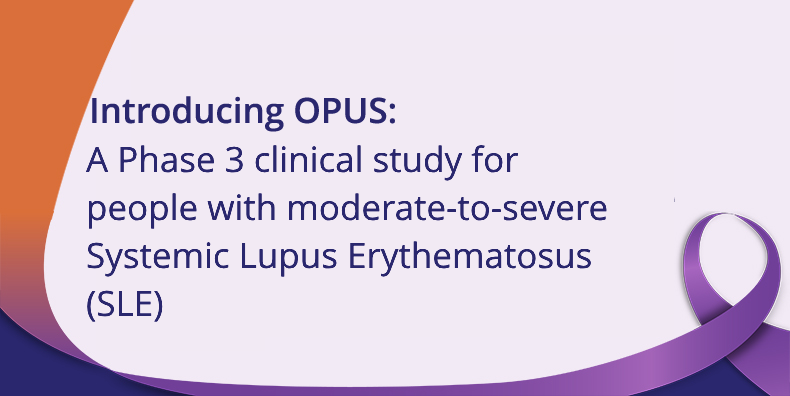WHAT IS A CLINICAL STUDY?
The purpose of a clinical study is to test new medicines in people living with specific diseases to help researchers understand their potential effect and safety for use in individuals with the condition.1

Phase 1 is the first clinical study to be done. It tests the safety of the investigational drug in humans for the first time. This is usually done in healthy volunteers without the disease.2
More than 150 healthy volunteers took cenerimod during the Phase 1 clinical studies.3,4,5,6,7,8

Phase 2 aims to establish the safety of the investigational drug in people living with the disease and possibly the best dose of the investigational drug (how much) to give people.2
More than 400 people with SLE took cenerimod during the Phase 2 studies.9,10

Phase 3 is done to evaluate if the investigational drug works in a larger number of people living with the disease.2
The OPUS clinical study is in this phase.
ABOUT THE OPUS CLINICAL STUDY

In the OPUS clinical study, a new investigational drug called cenerimod is being tested. Cenerimod is a tablet taken once per day, which works by keeping lymphocytes in the lymph nodes and reducing inflammation, so stopping the immune system from attacking your body.10,11,12
WHAT TO EXPECT?

The objectives of the OPUS clinical study are to test if cenerimod is effective in reducing the symptoms of SLE and collect the safety information related to the drug.

The OPUS clinical study is described as “double-blind”, which means that neither the participants nor their medical team will know if they are given cenerimod or a placebo [see glossary]. This will be decided at random by a computer.


The investigational drug is a tablet taken by mouth once per day, every day. Participants in the OPUS clinical study will keep taking their current SLE treatment as agreed with by their doctor. Participants will in addition receive the investigational drug or placebo.

At the end of the OPUS clinical study, participants may be offered the choice to join a clinical study where they can continue to receive cenerimod while being followed by their medical team for 1 to 3 years. Individuals joining this program will not need to take a placebo.
WHAT IS INVOLVED IN TAKING PART IN THE OPUS CLINICAL STUDY?
Upon confirmation of your eligibility to participate in the OPUS clinical study, you will receive cenerimod or a placebo depending on which group you get assigned to after randomization. Regardless of whether you receive cenerimod or a placebo, you will continue to receive your current SLE treatment. You will also have regular health assessments by your medical team including close monitoring and immediate support while you participate in the OPUS clinical study.
Potential Benefits
You will receive specialized care and close monitoring from a dedicated clinical study medical team working alongside your usual healthcare provider.
If you receive cenerimod, you may see an improvement of your symptoms.
The results from the OPUS clinical study will help describe the safety and effectiveness of cenerimod and its use along with your other medicines.
Potential Risks and Drawbacks
You may have to visit the clinic or hospital more regularly than you normally would for your SLE management. This will allow your clinical study medical team to check on your health and perform the tests planned in the OPUS clinical study.
If you receive placebo, you may not directly benefit from the use of the investigational drug.
The study treatment may not help you feel better. You may experience unpleasant side effects from the investigational drug.
ARE YOU ELIGIBLE FOR PARTICIPATION IN THE OPUS CLINICAL STUDY?
To make sure that the results of the OPUS clinical study are accurate and can be compared with other SLE clinical studies around the world, everyone who participates must meet certain safety and health requirements, called ‘eligibility criteria’. These eligibility criteria help researchers make sure that everyone in the clinical study is similar in certain important ways. This similarity allows the researchers to clearly see how the investigational drug affects people around the world.
For the OPUS clinical study, potential participants must meet the following main requirements:
Have a confirmed diagnosis of SLE and be currently experiencing symptoms of the disease
Be aged 18 years or older
Be prepared to keep taking their current SLE treatment together with the investigational drug or placebo
Must not be pregnant or planning to be pregnant for the duration of the clinical study
The medical team at the clinic or hospital will ask you questions about your health and any medications you are taking, and perform some tests to see whether you are eligible for the OPUS clinical study.
Please note that all study-related visits, tests, and investigational drug are provided at no cost. In addition, reimbursement for study-related travel and time may be provided to people who qualify, depending on country-specific law.
You can ask your medical team about the possibility of reimbursement for study-related travel and time when you enroll in the OPUS clinical study.
RECRUITING COUNTRIES
OPUS-1 and OPUS-2 are recruiting in 25+ countries:
North America
 United States
United States Puerto Rico
Puerto Rico Mexico
Mexico
South America
 Chile
Chile Peru
Peru Argentina
Argentina Colombia
Colombia Brazil
Brazil
Asia Pacific
 Malaysia
Malaysia Philippines
Philippines Taiwan
Taiwan South Korea
South Korea Thailand
Thailand
Europe
 Georgia
Georgia Poland
Poland Bulgaria
Bulgaria Serbia
Serbia Portugal
Portugal Spain
Spain Czech Republic
Czech Republic Greece
Greece Germany
Germany Romania
Romania Ukraine
Ukraine UK
UK France
France
Africa
 Egypt
Egypt South Africa
South Africa
FIND YOUR NEAREST STUDY SITE
study site without storing any of your information.
GLOSSARY
There are a lot of terms surrounding clinical studies that may be unfamiliar to you. We have included some of the most common ones below that are also used in the description of the OPUS clinical study.
Please ask your clinical study medical team to explain any other terms if you are unsure of their meaning. Sometimes healthcare professionals and researchers forget that these words are not part of everyday conversation for most people, so you should never feel embarrassed about asking!
| Term | Definition |
|---|---|
| Double-blind13 | A clinical study in which neither the medical team NOR the participants know who is receiving the investigational drug or the placebo. |
| Informed Consent14 | It means that the participant has freely agreed to take part, after discussing with the study doctor and reading about the clinical study. This is required before anyone enters a clinical study. |
| Investigational Drug15 | A drug that is not yet available on the market (cannot be prescribed) but is being studied in a clinical study. |
| Lymphocytes16 | A type of white blood cells that help protect the body from infections by identifying and attacking harmful substances, like viruses and bacteria. |
| Lymph nodes17,18 | Lymph nodes are small structures located in various places throughout the body. They are part of the immune system, which protects from infections. When there is an infection, samples from the affected areas in the body are brought to the lymph nodes and presented to lymphocytes. These lymphocytes can then leave the lymph node and travel the area of infection. |
| Open-label Clinical Study2 | A clinical study in which both the clinical study medical team and the participants know the treatment being received by the participant (investigational drug or placebo). |
| Placebo13 | A placebo looks like the drug being studied but has no active substance in it. |
| Protocol14 | The detailed plan that ensures that the clinical study is performed the same way at all participating clinics and hospitals. |
| Randomized13 | Meaning that the choice of who receives the investigational drug or placebo is made at random (by a computer) |
References:
1. National Institute of Health. How Clinical Trials Work. Available at: https://www.nhlbi.nih.gov/research/clinical-trials/how-studies-work. Accessed Mar 2025.
2. ClinicalTrials.gov. Glossary Terms. Available at: ClinicalTrials.gov Glossary Terms | ClinicalTrials.gov. Accessed Nov 2024.
3. Juif PE, Ufer M, Dingemanse J. Cardiodynamic Interactions between Two S1P1 Receptor Modulators in an Experimental Clinical Setting: Different Pharmacokinetic Properties as an Opportunity to Mitigate First-Dose Heart Rate Effects. Int J Mol Sci. 2019 Jul; 20(13):32320.
4. Juif PE, Baldoni D, Reyes M, Wilbraham D, Febbraro S, Vaclavkova A, Hoch M, Dingemanse J. Pharmacokinetics, Pharmacodynamics, Tolerability, and Food Effect of Cenerimod, a Selective S1P1 Receptor Modulator in Healthy Subjects. Int J Mol Sci. 2017 Dec 6;18(12):2636.
5. Boof ML, van Lier JJ, English S, Fischer H, Ufer M, Dingemanse J. Absorption, distribution, metabolism, and excretion of cenerimod, a selective S1P1 receptor modulator in healthy subjects. Xenobiotica. 2020 Aug;50(8):947-956.
6. Juif PE, Dingemanse J, Winkle P, Ufer M. Pharmacokinetics and Pharmacodynamics of Cenerimod, A Selective S1P1 R Modulator, Are Not Affected by Ethnicity in Healthy Asian and White Subjects. Clin Transl Sci. 2021 Jan;14(1):143-147.
7. Juif PE, Mueller MS, Charfi H, Dingemanse J. Lack of Effect of Cenerimod, a Selective S1P1 Receptor Modulator, on the Pharmacokinetics of a Combined Oral Contraceptive. Int J Mol Sci. 2022 Nov 29;23(23):14986.
8. Mueller MS, Juif P-E, Charfi H, Dingemanse J. Multiple-dose pharmacokinetics of cenerimod and the effect of charcoal on its elimination. J Clin Pharmacol. 2024;64(12):1566–1575.
9. Hermann V, Batalov A, Smakotina S, Juif PE, Cornelisse P. First use of cenerimod, a selective S1P1 receptor modulator, for the treatment of SLE: a double-blind, randomised, placebo-controlled, proof-of-concept study. Lupus Sci Med. 2019 Nov 9;6(1):e000354.
10. Askanase A, Berkani O, Cahuzac c, Cornelisse p, D'Cruz D, Kalunian K, Merrill J, Pozzobon M, Navarra S. Efficacy and Safety of Cenerimod in Patients with Moderate to Severe Systemic Lupus Erythematosus (SLE): A Multicenter, Randomized, Parallel-Group, Double-Blind, Placebo-Controlled, Dose-Finding Phase 2b Trial [abstract]. Arthritis Rheumatol. 2022; 74 (suppl 9): 3293–3297.
11. Hoyler TF, Strasser DS, Berkani O, et al. LO-016 The multifaceted immunomodulatory properties of cenerimod, a selective S1P1 receptor modulator, target three key aspects of SLE pathogenesis. Lupus Sci Med. 2023;10.
12. Gerossier E, Nayar S, Froidevaux S, et al. Cenerimod, a selective S1P1 receptor modulator, improves organ-specific disease outcomes in animal models of Sjögren's syndrome. Arthritis Res Ther. 2021;23(1):289.
13. National Institute of Health. Clinical Research Trials and You. Glossary of Common Terms. Available at: Glossary of Common Terms | National Institutes of Health (NIH). Accessed Nov 2024.
14. The basics. NIH Clinical Research Trials and You. Available at: The Basics | National Institutes of Health (NIH). Accessed Nov 2024.
15. What is an investigational new drug. NIH. . Available at: https://www.niaid.nih.gov/grants-contracts/investigational-new-drug-definition. Accessed Nov 2024.
16. National Institute of Health. National Human Genome Research Institute. Lymphocyte. Available at: https://www.genome.gov/genetics-glossary/Lymphocyte. Accessed Mar 2025.
17. National Institute of Allergy and Infectious Diseases. NIH. Overview of the Immune System. Available at: https://www.niaid.nih.gov/research/immune-system-overview. Accessed Jan 2025.
18. National Institute of Health. Glossary. Immunobiology: The Immune System in Health and Disease. 5th edition. Available at: https://www.ncbi.nlm.nih.gov/books/NBK10759/#IX-L. Accessed Jan 2025.



